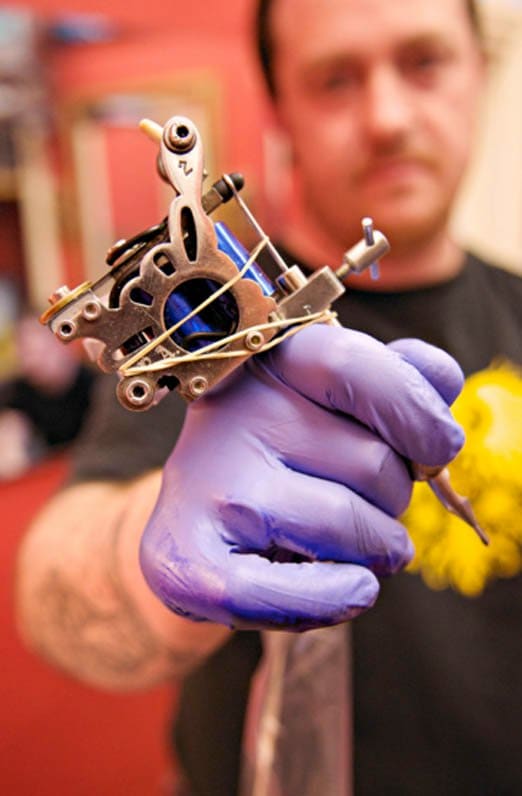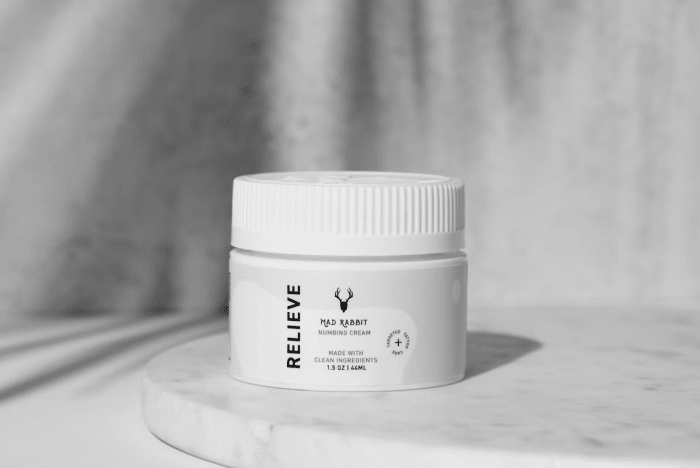Tattoos can be painful, especially depending on where on the body you place them. There’s a lot going on in your new tattoo, but ultimately when you choose to go under the gun, your artist is essentially creating a fresh wound.
Before we start this age-old debate on whether or not you should choose to use a topical numbing cream For your next tattoo, let’s take a look at understanding the tattooing process – the tattoo machine, the stroke, and the needle – to better guide your pre-tattoo decision.
The tattoo machine
The machine used in the tattoo parlor is called a tattoo machine. It’s that simple. Some people know it as a tattoo gun—but that term has fallen out of favor.
It comes in a few different forms, but essentially it’s a few mechanisms working together to mechanize the needle that penetrates the skin with tattoo ink.
There are three main types of tattoo machines. They all perform the same task, but how they do it is different.
- Rotation: This machine works with an electric motor and a rotating part with a pin. The rounded end of a needle attaches to the pen. The pin is then electrically engaged causing the wheel to rotate. It gets its name from this rotation. A rotary machine is preferred for shading and is easier to use than a coil machine.
- Coil: A coil machine is powered by electricity and magnets. Coil machines have two electromagnetic coils that look like fat, short batteries. The coil machine comes with a foot pedal. When the pedal is pressed, current flows to the coils. The coils magnetize and pull down the magnetic rod above, called the anchor rod. If this rod falls, it loses contact with a contact screw. The contact screw closes the circuit. So if the rod falls, it breaks the circuit, the coils lose their magnetism and the rod springs back to meet the screw again, and the whole system repeats. The needle is attached to the anchor rod, causing the needle to move up and down like a hammer. It tends to have more movement than a rotary machine. For line work, a coil machine is often preferable. The iconic tattoo buzz comes from this machine.
- Pneumatic: A pneumatic tattoo machine uses compressed air. Adjusting the air pressure controls the speed at which the machine moves the needles up and down. A pneumatic machine produces the least noise and is the lightest of the three machine types. You don’t see as many artists using pneumatics because they’re more expensive than the other machines and just aren’t a fan favorite. That’s not to say they’re not a useful or good choice — just far from popular.
Your tattoo artist will use whatever machine they are most comfortable with. Most experienced artists know how to use the coil and the rotary machine and can switch between them depending on what your tattoo design calls for.
dash length
Stroke length is how far a needle moves up and down. It depends on how the machine is built. Why is stroke length important? The longer the stroke length, the slower the machine. The shorter the stroke length, the faster the machine.
A shorter stroke length means less travel and a faster machine – vice versa for a longer stroke machine.
A short stroke length is typically around 1.8-2.5mm. A shorter stroke length works better for shading. The machine works faster and the needle doesn’t penetrate your skin as deeply, allowing the artist to shade and layer the ink. A faster stroke means the needle penetrates your skin faster.
A longer stroke length is about 4.0 mm or more. It is better for line work and accuracy. It delivers more ink in a single stroke and is stiffer, allowing you to use larger needles with a longer stroke machine. A longer stroke length means the needle penetrates your skin more slowly.
Anything between these two sizes works best for color packaging.
tattoo needles
There are many different types of tattoo needles – think of them like an artist’s brush.
The basic breakdown is as follows: A needle is not just a needle. It is a grouping of needles in a specific shape. The shape of this bundle changes and the number of needles changes.
Some needles are better for fine line work, some are better for color packing, and some are better for shading. All needles used in your tattoo should be sterilized and single use only.
The size of the needles that make up an arrangement is called the gauge. An 8 gauge has a diameter of 0.25 mm, a 12 gauge has a diameter of 0.35 mm.
The Pin Count (the number of pins that make up an arrangement) uses a number as a reference. For example, your artist might choose an 8 Gauge 03 Round Liner to make fine lines on your tattoo. This is a tightly packed needle assembly of three 0.25mm needle pins.
For a tattoo area where you need an even layer of lots of color pigment, your artist may choose a 12 gauge 27 magnum shader. This is a brush-like arrangement of 27 0.35mm needle pins.
When your artist prepares for your tattoo session, they’ll already have a good idea of what needles they’ll need for the different parts of the tattoo, so they’ll add them to their workspace ahead of time.
The great debate about numbing creams
Finally with a numbing cream comes down to personal preference. If you’re new to tattooing and are nervous about your first tattoo or sensitive to pain and likely to move during your appointment, a numbing cream can be wise to soothe and keep you calm while your artist works on your new piece body art. If you are a tattoo veteran, you can do without a numbing cream.
If you decide to use a numbing cream, look for one with clean ingredients and a topical numbing agent like lidocaine—Mad Rabbit Numbing Cream uses clinically proven ingredients like 5% lidocaine to effectively numb the area before your tattoo appointment. A combination of antibacterial, anti-inflammatory ingredients and lightweight moisturizers support the skin’s natural barrier to relieve irritability and promote optimal skin function: both on the surface and underneath.
Check out some testimonials from Mad Rabbit customers using the new numbing cream
How to use Mad Rabbit’s numbing cream
Step 1: Prepare skin – shave if necessary.
Step 2: Apply Mad Rabbit Tattoo Numbing Cream generously.
Step 3: Wrap the area with plastic wrap.
Step 4: Wait 45 minutes – 1 hour.
Step 5: Unpack and clean the canvas area.
Step 6: Sit Back and Relax!
Whatever you decide, don’t forget tattoo aftercare
The first few healing days after the tattoo are the most delicate and require special care. The blood clots and crusts form in the first few days. Be sure to use a light, breathable moisturizer such as Mad Rabbit Soothing Gel instead of a petroleum-based ointment.
After the third day until the end of the second week, your tattooed skin will close. The scabs become harder and the skin becomes scaly. You will likely feel most of your itchiness in that first week or two.
By the third or fourth week, the scab will begin to fall off and your tattoo will become a closed wound. This means your tattoo is still healing beneath the surface of the skin, but on the surface it has finished healing and is sealed off from bacteria.
Overall, it takes about three to four months for a tattoo to heal and look the way you envisioned it. It may look healed before those three or four months, but the skin underneath is still healing around the ink, so make sure you use lotion and moisturizer – try it Mad Rabbit daily tattoo skin care routine products or Mad Rabbit Tattoo Balm to keep tattoos alive.
Let us know – are you team numb or team pain?


